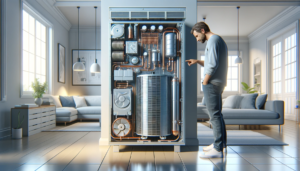HVAC System Warranties: What Homeowners Need to Understand
 Beyond just selecting the right system, understanding the nuances of HVAC warranties is important for homeowners.
Beyond just selecting the right system, understanding the nuances of HVAC warranties is important for homeowners.
These warranties not only protect your investment but also ensure that your system continues to function effectively, keeping your home free from allergens like pollen, dust mites, and pet dander. Here’s what you need to know about HVAC warranties to make an informed decision and ensure optimal performance.
Understanding HVAC Warranties
An HVAC warranty is essentially a promise from the manufacturer to the homeowner that the product will perform as advertised for a certain period. These warranties typically cover parts and sometimes labor, ensuring that any malfunctions within this period do not incur additional costs to the homeowner.
Types of HVAC Warranties
- Manufacturer’s Warranty: This usually covers the HVAC unit itself, including the compressor, coils, and other internal components. It’s important to note that these warranties do not cover damages due to improper installation or maintenance.
- Extended Warranty: Offered either by the manufacturer or a third party, extended warranties can lengthen the period of coverage. These often come at an additional cost and can cover parts, labor, or both.
- Labor Warranty: Some HVAC installers offer their own warranties that cover the labor cost of repairs during the warranty period. This is crucial because labor can be a significant expense if something goes wrong.
Keep in mind that customers typically receive an extended parts warranty when their equipment is registered with the manufacturer (Jacobs and Rhodes performs this task for you). In addition, refrigerant is also not covered under warranty as well, which can definitely increase the price of repair.
Key Components Covered Under HVAC Warranties
When investing in an HVAC system, understanding the coverage of its warranty is as crucial as understanding its operational mechanics, especially for components that are susceptible to breakdowns and costly to replace. Here’s a closer look at the major components typically covered under most HVAC warranties, highlighting their function and importance in your home’s heating and cooling efficiency.
Compressors
The compressor is often referred to as the “heart” of your air conditioning system. It has the critical role of circulating refrigerant throughout the unit, enabling the cooling cycle that lowers the temperature of your home. The compressor compresses the refrigerant, which absorbs heat from the indoor air when it evaporates in the evaporator coil and releases the heat outside in the condenser coil. Due to its constant use and vital role, the compressor is a component that’s not only prone to wear but also expensive to repair or replace. Most HVAC warranties will cover this component, ensuring that if a breakdown occurs, the homeowner won’t face the hefty costs associated with its repair or replacement.
Heat Exchangers
Found primarily in furnaces, heat exchangers play a pivotal role in heating your home. They work by transferring heat from the combustion gasses produced by the furnace to the air that circulates through your home’s ductwork. This process is crucial for maintaining comfortable temperatures during colder months. Heat exchangers are subjected to extreme temperatures and constant heating cycles, which can lead to stress fractures or corrosion over time. Given the costs involved in replacing a heat exchanger, having this component under warranty can provide significant financial relief in the event of a malfunction.
Coils
Evaporator and condenser coils are essential components in the heat transfer process. The evaporator coil is located inside or near the air handler where it absorbs heat from the air passing over it, while the condenser coil releases the absorbed heat outside. These coils are crucial for effective air conditioning and heating. They are prone to issues like freezing over, becoming clogged with dust and debris, or corroding due to environmental factors. Replacement or repair can be quite costly due to the labor involved and the price of the coil itself.
Importance of Warranty Coverage
Understanding what is covered by your HVAC warranty is essential for several reasons. First, it ensures that you are aware of and can plan for any potential out-of-pocket costs for parts not included under the warranty. Second, it helps in maintaining your HVAC system in optimal condition without undue financial burden, thereby extending the lifespan of the system and ensuring it runs efficiently. Efficient operation is not just about comfort but also about maintaining the air quality in your home, crucial for households concerned with allergens.
In essence, HVAC warranties that cover these key components can save homeowners considerable expense and inconvenience, ensuring that the system continues to function effectively and efficiently. This peace of mind is invaluable, especially considering the role of the HVAC system in filtering allergens and maintaining a comfortable and healthy living environment.
Limitations and Exclusions to Look Out For
It’s important to read the fine print of your HVAC warranty to understand what is not covered. Common exclusions include:
- Normal Wear and Tear: Over time, some parts of the HVAC system may degrade. These are generally not covered under warranty.
- Improper Use: Any damage resulting from misuse or neglect is typically not covered.
- Natural Disasters: Most warranties will not cover damages from fires, floods, earthquakes, or other natural events.
Conclusion
For homeowners, understanding the specifics of HVAC warranties is as crucial as selecting the right system. These warranties protect against unexpected costs and ensure your HVAC system functions efficiently, providing a healthier living environment.
Always choose a reputable manufacturer and installer, adhere to maintenance requirements, and ensure that your warranty covers the most critical components of your system.
By doing so, you not only safeguard your investment but also enhance your home’s air quality and comfort.

 Jacobs and Rhodes
Jacobs and Rhodes Jacobs and Rhodes
Jacobs and Rhodes